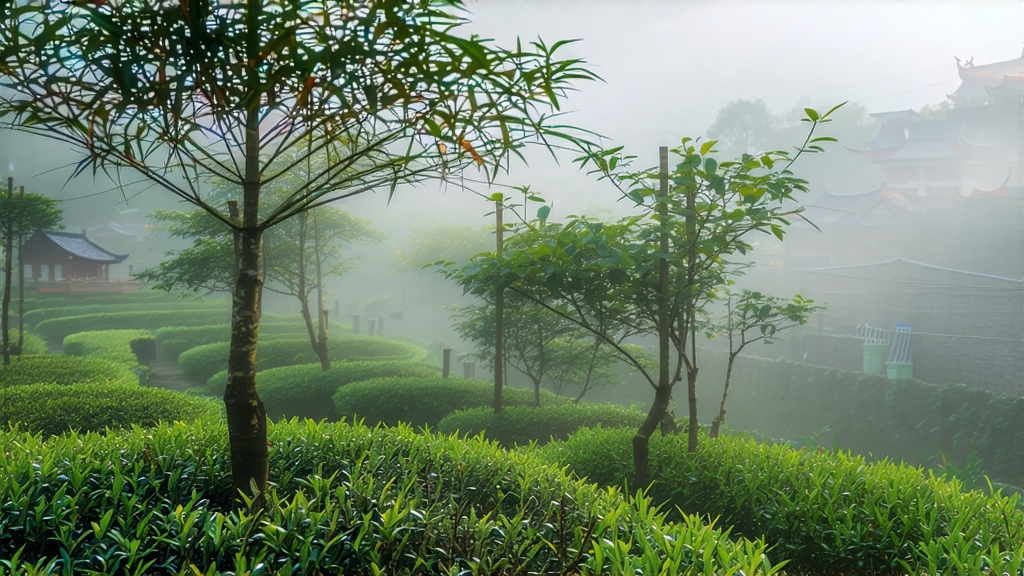
When Chinese tea lovers speak of “white tea,” they are not referring to a pale liquor alone but to a whole philosophy of restraint. Among the six major tea families, white tea is the least tempered by human hands, and within that family Fuding White Tea—grown on the hilly coast of northern Fujian—carries the most venerable pedigree. Its story begins in the early Song dynasty, when imperial tribute lists first recorded “white cakes” pressed from downy buds. Caravans carried these cakes along the Tea-Horse Road to Tibet, where aristocrats prized their cool, honeyed character. By the late Ming, loose-leaf fashion had arrived; Fuding growers discovered that simply air-drying the freshly plucked shoots preserved a silvery down and a flavor so soft it seemed to dissolve on the tongue. In 1796 the Qianlong Emperor’s court chronicler wrote that “Fuding tea resembles moonlight frozen at midnight,” a line that still adorns export tins today.
Fuding’s microclimate is the invisible co-author of its tea. The Taimu mountain range funnels humid air from the East China Sea, creating morning fogs that act like a natural shade-cloth. Slow photosynthesis raises the amino acid L-theanine, gifting the tea its signature sweetness. Granitic soils, rich in potassium and magnesium, lend a faint marine minerality that lingers like a sea breeze. Because the region lies just north of the subtropical belt, winters are cool enough to send the bushes into genuine dormancy, concentrating spring nutrients in the first flush. Local proverb claims “one day earlier is treasure, one day later is grass,” so plucking begins literally before dawn on Qingming festival, when dew still beads the buds and the mountain is silent except for cicadas.
Three traditional styles emerge from this landscape: Silver Needle (Yin Zhen), White Peony (Bai Mu Dan), and Shou Mei. Silver Needle is the aristocrat—only unopened leaf buds, plucked within a 48-hour window in late March. A skilled picker can gather barely one kilogram per day, curling each bud into a tiny harpoon of silver. White Peony adds the next two leaves, unfolding like petals around the needle; its liquor is duskier, with notes of ripe melon and narcissus. Shou Mei, harvested later, contains larger leaves and even stems; once considered peasant tea, it is now coveted for deep, dried-fruit sweetness and the ability to age into mahogany richness. All three, however, obey the same minimalist creed: no pan-firing, no rolling, no roasting—only withering and drying.
Withering is where science meets meditation. Fresh leaves are laid on bamboo trays stacked like screens in a ventilated loft. For 36 to 72 hours the master watches moisture drop from 75 % to 10 %, but the real transformation is enzymatic: chlorophyll breaks down, polyphenols oxidize just enough to round the edges, and a hay-like aroma drifts toward something between ripe peach and wet stone. The loft windows are opened or closed every half hour according to barometric readings; too much wind blackens the leaf, too little invites unwanted fermentation. When the leaf feels like crepe paper and smells like warm apricot, it is moved to a charcoal-warmed chamber for “low-temperature fixation” at 40 °C, halting oxidation while preserving the enzymes that will allow graceful aging. Finished tea is rested for at least a month so residual moisture equalizes; connoisseurs claim Silver Needle only begins to sing after the first lunar cycle.
Aging is the dimension that startles newcomers. Unlike green tea, which fades within a year, well-dried white tea improves for decades if stored below 30 °C and 60 % humidity. Over time catechins polymerize, caffeine complexes with tannins, and the liquor turns from pale chartreuse to deep amber. A 20-year-old Shou Mei brews the color of Madeira and tastes of honeycomb, sandalwood, and dried longan; Chinese pharmacies sell it as a “cooling” tonic for feverish children. Collectors in Guangzhou store cakes of compressed White Peong in clay jars, betting on appreciation like vintage wine. The 2018 Fuding municipal government even introduced a blockchain tag to certify vintage white tea, an odd marriage of Tang-dynasty craft and digital ledger.
Brewing Fuding white tea is an exercise in gentleness. Start with a tall glass or a thin-walled gaiwan so you can watch the buds stand upright like miniature submarine periscopes. Use 3